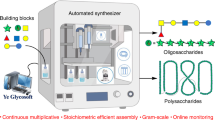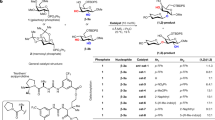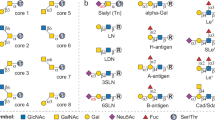Abstract
Complex glycosylation patterns on cell surfaces are involved in many fundamental biological processes like specific cell–cell interactions and signal transduction. Furthermore, the glycon part of glycopeptides and glycosylated proteins play a crucial role in numerous ligand–receptor interactions of biological significance. However, the distinct function of complex carbohydrate structures associated with cell surfaces and proteins is still only poorly understood at a molecular level with regard to specific carbohydrate–protein interaction. Here, we present an efficient Mitsunobu protocol for the convenient chemical one-pot preparation of S-glycosyl amino-acid building blocks suitable for automated combinatorial syntheses of highly glycosylated β-peptides, which, in turn, can serve as potential mimics for complex oligosaccharides or for studying carbohydrate–protein interactions. The protocol also describes the use of the S-glycosyl amino-acid building blocks for combinatorial spot syntheses of glycopeptide libraries and can be used for the construction of other combinatorial peptide libraries as well. This is a procedure that can be completed in approximately 7 days.
This is a preview of subscription content, access via your institution
Access options
Subscribe to this journal
Receive 12 print issues and online access
$259.00 per year
only $21.58 per issue
Buy this article
- Purchase on Springer Link
- Instant access to full article PDF
Prices may be subject to local taxes which are calculated during checkout






Similar content being viewed by others
References
Sharon, N. & Lis, H. Lectins as cell recognition molecules. Science 246, 227–234 (1989).
Seitz, O. Glycopeptide synthesis and the effects of glycosylation on protein structure and activity. ChemBioChem 1, 214–246 (2000).
Sampson, N.S., Mrksich, M. & Bertozzi, R.C. Surface molecular recognition. Proc. Natl. Acad. Sci. USA 98, 12870–12871 (2001).
Rudd, P.M., Elliott, T., Cresswell, P., Wilson, I.A. & Dwek, R.A. Glycosylation and the immune system. Science 291, 2370–2376 (2001).
Crocker, P.R. Mammalian Carbohydrate Recognition Systems 1–249 (Springer, Heidelberg, 2001).
Danishefsky, J.S. & Allen, J.R. From the laboratory to the clinic: a retrospective on fully synthetic carbohydrate-based anticancer vaccines. Angew. Chem. Int. Ed. Engl. 39, 836–863 (2000).
Schips, C. & Ziegler, T. A practical one-pot synthesis of new S-glycosyl amino acid building blocks for combinatorial neoglycopeptide synthesis. J. Carbohydr. Chem. 24, 773–788 (2005).
Frank, R. Spot-synthesis: an easy technique for the positionally addressable, parallel chemical synthesis on a membrane support. Tetrahedron 48, 9217–9232 (1992).
Frank, R. The SPOT-synthesis technique. Synthetic peptide arrays on membrane supports—principles and applications. J. Immunol. Methods 267, 13–26 (2002).
Toepert, F. et al. Combining SPOT synthesis and native peptide ligation to create large arrays of WW protein domains. Angew. Chem. Int. Ed. Engl. 42, 1136–1140 (2003).
Rink, H. Solid-phase synthesis of protected peptide fragments using a trialkoxy-diphenyl-methyl ester resin. Tetrahedron Lett. 28, 3787–3790 (1987).
Acknowledgements
We thank A. Just for performing the elemental analyses, K. Albert for measuring the NMR data, B. Kammerer for recording the MALDI-TOF MS and the Fond der Chemischen Industrie for financial support.
Author information
Authors and Affiliations
Corresponding author
Ethics declarations
Competing interests
The authors declare no competing financial interests.
Rights and permissions
About this article
Cite this article
Ziegler, T., Schips, C. An efficient Mitsunobu protocol for the one-pot synthesis of S-glycosyl amino-acid building blocks and their use in combinatorial spot synthesis of glycopeptide libraries. Nat Protoc 1, 1987–1994 (2006). https://doi.org/10.1038/nprot.2006.307
Published:
Issue Date:
DOI: https://doi.org/10.1038/nprot.2006.307
Comments
By submitting a comment you agree to abide by our Terms and Community Guidelines. If you find something abusive or that does not comply with our terms or guidelines please flag it as inappropriate.



